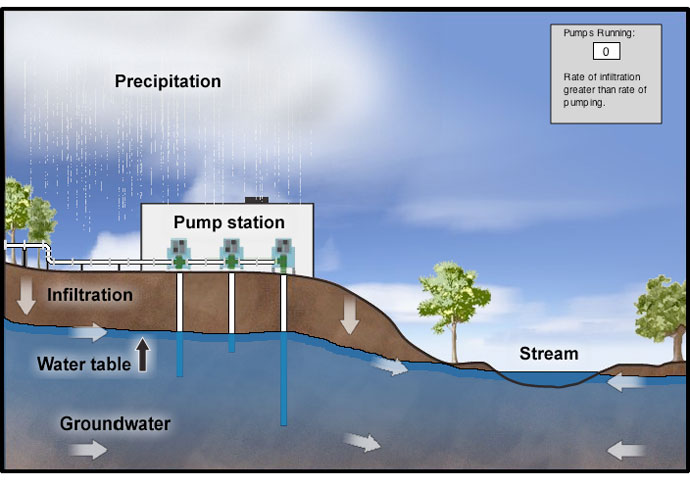Groundwater Use and Overuse
The biggest reservoir of fresh, liquid water on earth is groundwater. There is more than 20 times as much water stored within the ground as in all the lakes and rivers combined. In many parts of the world, agricultural, industrial, and domestic water demands can only be met by pumping water out of the ground.
As you'll see in the diagram below, wells work only if they penetrate the water table - the name given to the subsurface boundary that separates saturated and unsaturated ground. Above the water table, cracks and spaces between soil and rock particles contain at least some air. Infiltrating water moves more or less vertically as it passes through this unsaturated zone. Below the water table, all openings in the ground are filled with water. Once groundwater reaches this saturated zone, it begins to travel both horizontally and downward, and can flow into wells, rivers, and eventually the sea.
The water table is an irregular surface that generally resembles a gentler version of the overlying ground surface. It is not fixed, but moveable, rising when rainfall adds more water to the ground, and falling when drought reduces the water supply. The depth and shape of the water table can also change dramatically when groundwater is pumped out of the ground. Pumping can quickly draw down the local water table right around a well. Over time, excessive pumping can also lower the water table over a wide region.
Instructions: You are the city water master responsible for supplying water to local homes and farms. In the past, groundwater supplies have been adequate. But now a growing population has forced you to drill more wells, and you are concerned that increased pumping will affect water levels. In the simulation below, you can see what will happen when your pump station comes on line. Pumps can be activated by clicking repeatedly on the simulation. Try running 1, 2, and even all 3 pumps at once, to determine the impact of various rates of pumping on the groundwater and the wells.
Note: The behavior of the water table in the simulation has been simplified to make it easier to understand. For more detailed information on groundwater and wells, go to:
The U.S. Environmental Protection Agency ![]()
Questions
- Describe what happens to groundwater when the rate of pumping is less than the rate of infiltration.
[Check Answer]
In this situation, how do you think water needs can be met over the long-term?
- Look closely at the images of the mantis shrimp. The shrimp on the left is a male, and the one on the right is a female. Describe any differences between their polarized and unpolarized appearances.
[Check Answer]
As long as rainfall and infiltration replenishes the groundwater faster than humans use it, the groundwater supply is reliable and steady. Groundwater is a renewable resource in this situation, and can meet water needs into the future.
- Describe what happens to water levels when the rate of pumping is greater than the rate of infiltration.
[Check Answer]
The water table drops a lot, so much that some of the shallower wells run dry.
- In this situation, how do you think water needs can be met over the long-term?
[Check Answer]
When infiltration is unable to replace groundwater as quickly as pumping removes it, the water table drops. Deeper wells could be dug to chase the table, but then the water table will just drop even further. Over the long-term, groundwater is a non-renewable resource in this situation, and won't be able to supply all the needed water.
The population will either have to reduce its water usage, or find other sources of water.
Overuse of groundwater can cause wells to dry up. This often leads to expensive and ultimately futile attempts to keep up with the dropping water table by drilling deeper and deeper wells. Other serious consequences can also follow groundwater overuse.
- What happened to the stream as the water table dropped? What would have happened if that water body wasn't a stream, but an ocean?
[Check Answer]
Water was pulled out of the stream back into the groundwater as the water table dropped. If that had been an ocean, the water moving into the groundwater and into the nearby wells would be seawater. This would contaminate the water supply - salt water is toxic to land plants and animals, so it couldn't be used for drinking or irrigation, and it would harm machinery, so it couldn't be used industrially either.
When too much water is withdrawn from the ground, the land can collapse, a process called subsidence. When groundwater fills spaces in the soil, it supplies part of the internal strength of the ground. When the water is removed, leaving openings filled only with air, the weight of the overlying earth compacts and crushes the spaces.

In this photograph of California's San Joaquin Valley, the dates on the pole mark the former heights of the ground. In the span of 50 years, water pumping for irrigation led to nearly 30 feet of subsidence.
- What problems do you think subsidence might cause?
[Check Answer]
When the surface of the ground sinks, roads, buildings, and other structures on the land will be damaged. Where subsidence creates low-lying ground, there could be more frequent and more severe flooding. And because the spaces in the ground have been reduced, the capacity of the ground to hold water has been diminished, so there will be less water available in the future.
Related Links
Multimedia Discovery Missions: Lesson 7 - The Water Cycle


